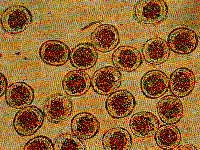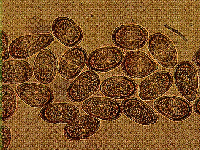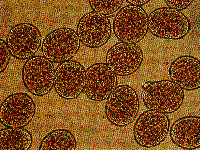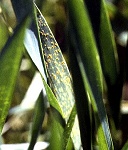

| March 1, 2004 |
 |
|---|
Leaf, Stem and Stripe Rust
Most producers are familiar with stem rust and leaf rust which can cause extensive damage. The fungi which cause these diseases, when left unchecked in favorable environmental conditions, can result in the loss of both grain yield and quality. The development of the fungi is impacted by water and temperatures. When favorable environmental conditions exist the life cycle for the spores can occur in 7 to 14 days. Frequent heavy dew, light rain, or high humidity and temperatures generally in the range of 59 to 77 degrees Fahrenheit (F) are ideal for rust development. Pustules form on the surface of the plant parts and contain thousands of microscopic spores. The pustules erupt releasing the new urediospores into the air and they are dispersed by the wind.
Urediospores germinate in rain or dew and infect leaves within 6 to 8 hours after settling on the plant surface. The infection element of the fungi is capable of penetrating into a plant directly and will enter through the plant breathing pores or wounds. Plants have many microscopic breathing pores called stomata on the surface of the leaves. This is a common spot of infestation. Once the fungal infestation element becomes established inside the plant, the invaded tissue gradually dies as the urediniospores develop. Shown in Figure 1, is the urediospores of leaf, stem and stripe rust. Rust spreads by wind blowing urediospores from plant to plant and from field to field until the crop matures.
 Leaf Rust |
 Stem Rust |
 Stripe Rust |
|---|
Stripe rust (Puccinia striiformis)
 Stripe rust is blown into our area by prevailing winds. Winds can carry rust spores for great distances. The disease can develop rapidly when moisture is not limited. Urediospores are yellow to orange in color and have an elongated shape. Urediospores lose their viability rapidly at temperatures above 59 F. Germination is best between 41 and 59 F, with limits at 32 and 68 F. Infection may occur through the winter since the mycelium remains viable to 23 F. The disease develops most rapidly between 50 and 59 F when intermittent rain or dew occurs. Many disease cycles may take place in one season, since the time between infection and sporulation under optimal conditions is about 8 days. Cool, wet falls; mild, open winters; and long, cool, wet springs favor stripe rust.
Stripe rust is blown into our area by prevailing winds. Winds can carry rust spores for great distances. The disease can develop rapidly when moisture is not limited. Urediospores are yellow to orange in color and have an elongated shape. Urediospores lose their viability rapidly at temperatures above 59 F. Germination is best between 41 and 59 F, with limits at 32 and 68 F. Infection may occur through the winter since the mycelium remains viable to 23 F. The disease develops most rapidly between 50 and 59 F when intermittent rain or dew occurs. Many disease cycles may take place in one season, since the time between infection and sporulation under optimal conditions is about 8 days. Cool, wet falls; mild, open winters; and long, cool, wet springs favor stripe rust.
For more information about stripe rust and fungicide recommendations (click here).
Leaf rust (Puccinia recondita)
Leaf rust is blown into our area by prevailing winds.  Winds can carry rust spores for great distances. The disease can develop rapidly at temperatures of 52 to 72 degrees F, when moisture is not a limiting factor. The optimum temperature for sporulation and infestation is approximately 70 degrees F and infestation can occur within four hours if leaves are wet. The spores can initially infect and produce pustules where the raindrops have collected at leaf axils and tips. New pustules erupt within 7 to 10 days. Rust development is slowed drastically with cooler temperatures or a shorter leaf wetting period. At 60 degrees F, a wetting period of 8 to 10 hours is necessary. Very wet conditions reduce spore dispersal. Epidemics generally develop when favorable moisture exists and temperatures are above 60 degrees F.
Winds can carry rust spores for great distances. The disease can develop rapidly at temperatures of 52 to 72 degrees F, when moisture is not a limiting factor. The optimum temperature for sporulation and infestation is approximately 70 degrees F and infestation can occur within four hours if leaves are wet. The spores can initially infect and produce pustules where the raindrops have collected at leaf axils and tips. New pustules erupt within 7 to 10 days. Rust development is slowed drastically with cooler temperatures or a shorter leaf wetting period. At 60 degrees F, a wetting period of 8 to 10 hours is necessary. Very wet conditions reduce spore dispersal. Epidemics generally develop when favorable moisture exists and temperatures are above 60 degrees F.
Leaf rust pustules (uredia) develop primarily on the upper surface of leaf blades. Pustules are round to oval, about 1/50 inch in diameter (about the size of a pinhead), and filled with thousands of orange-red spores (urediospores). These spores are easily dislodged by the wind or rubbing and accumulate as red dust on hands, clothing, and machinery. They may occur on stems but are most common on the upper surface of the leaves. Rust increases water loss from leaves so they die prematurely.
Since the leaf rust loss results from the early kill of the upper two wheat leaves, the faster an epidemic develops, the greater the loss. Loss can be roughly predicted by matching severity on the flag leaf with growth stage. If the flag leaf is severely damaged prior to the milk stage, the approximate loss in yield is 25 to 40 percent. If the disease damages the flag leaf between the soft and hard dough stages of the developing wheat, yield losses are usually less than 10 percent.
Stem rust (Puccinia graminis)
A wave of infection usually advances northward by wind-blown spores released from infected wheat or barley plants.  Stem rust usually enters our area in late March to mid-April depending on weather conditions and the extent of disease development on cereal crops south of us. The disease usually appears on plants in early spring.
Stem rust usually enters our area in late March to mid-April depending on weather conditions and the extent of disease development on cereal crops south of us. The disease usually appears on plants in early spring.
After infection, pustules form in 7-10 days. The pustules break open, releasing masses of spores that can infect surrounding plants. Temperatures of 68 to 77 degrees F favor stem rust development. Rust spots are very small, circular or elongated, and vivid orange-red in color. Later in the year, the rust pustules darken because of the production of dark-brown-black spores which are the overwintering stage of the rust.
Infected plants usually produce fewer tillers, set fewer seeds per head, and yield small shrivelled seeds with poor milling quality and food value.
Freeze Injury In Small Grains
In March 2003, we had a cold front with freezing temperatures come through our region which reduced wheat yields by about 25 percent in Concho, McCulloch and Runnels Counties. Several agents were involved in checking wheat fields for injury and were asked to make recommendations concerning the best use of the wheat crop. As the wheat starts to grow in the spring, it becomes more sensitive to low temperatures. It only takes about two hours of cold temperatures to injure the wheat. You may want to review the information on freeze injury in wheat (click here).
The following counties have made their cottonseed requests for 2004: Howard, Glasscock, Reagan, Upton, Nolan, and Scurry. I will be calling companies soon to make seed request.
Cotton variety information from 2003 tests conducted in Glasscock, Reagan and Upton Counties; Howard County; Runnels and Tom Green Counties; Jones, Mitchell, Nolan and Scurry Counties; Midland County; and Fisher County are now available.
I am hearing a cautious note in a number of producers questions. They are asking how to produce a healthy crop with the least amount of financial risk. The first thing I would suggest is to take a soil test. We need to see how much available nitrogen is in the soil. If a producer has 20 pounds of available nitrogen in the upper 6 inches of soil this will meet the cotton's need until the one-third grown square stage. By that time, the producer should know if an adequate crop is established and the soil moisture availability. The producer can then side-dress the crop using a chisel rig or wait until bloom and apply nitrogen using foliar applications. The soil applied fertilizer is less expensive than a foliar program, however, the application should be completed by the time the first squares are one-third grown. The cotton plant roots need to have time to recover from the fertilizer application before it begins to bloom.
On Monday, March 8, there will be a training conducted at Abilene for producers needing to obtain a Private Applicators License. For more details and to register for the meeting call Gary Bomar at (325) 672-6048.
The Agricultural Waste Pesticide Collection Events scheduled for April 2004 are listed on the Texas Commission on Environmental Quality (TCEQ) Website (http://www.tnrcc.state.tx.us/exec/oppr/agwaste/agwaste.html).
Several of you conduct grain sorghum and forage sorghum variety tests each year. Sometimes these demonstration plots are short fused with varieties needed quickly. By selecting varieties from the same maturity group you will save yourself a lot of problems. Two main problems that can be avoided is timing insecticide applications and harvesting the plot within a short time frame.
From the variety tests conducted over the past five years, we have found that producers management practices have the greatest impact on the quality of forage being harvested as hay or forage. Before spending a lot of time and effort on a variety test you need to select a producer that has good management practices.
Several agents indicated that it would be useful to have the weeds grouped by bloom color. Linked are pictures of weeds sorted by bloom color. Weeds that have yellow blooms, white blooms, and purple blooms in the spring. Each small picture is linked to a larger picture.
 March 1, District 7 Headquarters, Office Conference
March 1, District 7 Headquarters, Office Conference
 March 1, Upton County, Soil and Soil Fertility
March 1, Upton County, Soil and Soil Fertility
 March 4, Martin County, Multi-County Planning Meeting
March 4, Martin County, Multi-County Planning Meeting
 March 4, Midland County, Small Pasture Management Meeting
March 4, Midland County, Small Pasture Management Meeting
 March 8, Brown County, Brown County Ag Day
March 8, Brown County, Brown County Ag Day
 March 11, Taylor County, Soil and Soil Fertility
March 11, Taylor County, Soil and Soil Fertility
 March 16, Nolan County, IPM Steering Committee Meeting
March 16, Nolan County, IPM Steering Committee Meeting
 March 19, Tom Green County, Professional Ag Workers
March 19, Tom Green County, Professional Ag Workers
 March 25, Howard County, Cotton Production Meeting
March 25, Howard County, Cotton Production Meeting
 March 26, Annual Leave
March 26, Annual Leave
 March 31, Nolan County, Lower Rolling Plains Ag Conference
March 31, Nolan County, Lower Rolling Plains Ag Conference
 April 1, Burnet County, Soil and Soil Fertility
April 1, Burnet County, Soil and Soil Fertility
 April 2, Runnels County, Regional Ag Day
April 2, Runnels County, Regional Ag Day
 April 5, District 7 Headquarters, Office Conference
April 5, District 7 Headquarters, Office Conference
 April 16 - 18, Brazos County, Parents Weekend at Texas A&M
April 16 - 18, Brazos County, Parents Weekend at Texas A&M
 April 27 & 28, Brown County, Professional Board Meeting
April 27 & 28, Brown County, Professional Board Meeting
 April 29, Tom Green County, Natural Resources Field Day
April 29, Tom Green County, Natural Resources Field Day
Sincerely,
|